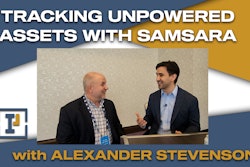
Contractors mostly run mixed fleets. We know that. Telematics and construction equipment tracking software has evolved to bring in data from multiple original equipment manufacturers. Vendors like Tenna, Fleetio, Trackunit, HCSS, B2W, Equipmentshare T3 offer the ability to bring in data across multiple OEMs, and often some proprietary tracking or telematics hardware, all on one pane of glass.
Getting this massive amount of data in one place creates opportunities construction and fleet executives ought to consider, but GPS equipment tracking software available on the market varies in terms of how it enables users to milk insight and value from the data. This is where Scottsdale, Ariz.-based Foresight Intelligence & Fleet Intelligence has a strong story to tell.
“We can track utilization and uptime,” Foresight Intelligence CEO Dale Hanna said. “Then we have a scheduling module and route optimization. For people who want to go even further, we have analysis of the fleet, which is the predictor of maintenance cost and the maintenance schedule. The reason we have this stuff is first I started as a business intelligence company. So we already have the backbone to do a lot of the analytics.”

Foresight Intelligence CEO Dale Hanna
The fact that this is an analytics software product for equipment data is significant as most of the market is focused on operational tracking, with perhaps maintenance and some analytics screens. In 2017, John Deere announced it had added Foresight Intelligence as one of its endorsed solutions for dealers. Foresight’s Intelligent Alert Triage Center (IATC) was being used to manage alerts from machines.
As covered by ForConstructionPros, Foresight’s Fleet Intelligence product became part of John Deere’s Worksight, that OEM’s telematics data analytics and optimization application.
While business analytics software is a crowded field from Microsoft Power BI on down, Foresight Intelligence through its deep involvement in construction equipment data has amassed a storehouse of standard analytics content focused on the industry. Capabilities include its triage tool, utilization/job cost, rental management, digital inspections, equipment scheduling and route optimization. It also extends into over-the-road fleet visibility with tools for electronic logging devices (ELD) and driver behavior and score cards.
Beyond analytics, Foresight Intelligence has extended to encompass data sets from other OEMs’ telematics applications, plus hardware options for attachment tracking, aggregate applications and driver safety.
The functionality is broad, and Hanna describes the company’s current Fleet Intelligence product offering as consisting of a foundation of data collection from equipment augmented with multiple a la carte analytics and management tools.
“Someone may buy Express, which is what we had when we first started in 2017—just hours and location,” Hanna said. “Or, they can do Express plus one, with the choice of adding preventive maintenance, work orders, inspections, fault codes, fluid analysis results, sophisticated utilization. You can do Express plus two, Express plus three. And you have the Platinum, which is what most people would want, which has to do with utilization and uptime.”
Other modules cover transformational capabilities to analyze the fleet, predictive maintenance cost analytics and maintenance scheduling.
Predictive Construction Equipment Maintenance Analytics
Because Foresight and the Fleet Intelligence solution is aggregating not only telematics data and fault codes from different OEMs but other data streams including fluid analysis and inspections, users can begin to gain predictive insights into the fleet.
“We start with condition monitoring,” Hanna said. “There's the element of a preventive maintenance inspection, fluid analysis and fault codes. If you look at those together with utilization which you have as part of preventive maintenance, you have better insights. Should a maintenance action be done earlier? Is there a problem that could happen that's much cheaper to address now? So that's what we're focusing on—from those four areas of data is there some type of algorithmic approach that surfaces this information for people?”
After getting its start in condition monitoring for dealerships, those dealers got Foresight Intelligence involved with their customers, which got the company started on its offerings for contractors and other equipment fleet owners.
Even as the sources of data and the operations the software can perform upon it evolve, Hanna insists the company has been and will continue to be based on data integrity—which is a prerequisite for analytics.
“This company started as a data company,” Hanna said. “And so we maintain very, very clean data—that is the foundation of what we do. The volume of data continues to increase, the complexity continues to increase and every manufacturer is producing more data with each generation of new machines. We integrate with over 60 third parties. We have a four-tiered monitoring system running 24/7, and we're usually the ones that tell everybody, ‘hey, your system's not working.’ We know, usually within an hour or so, what's going on. So that's the foundation.”
In November, the company announced its current AI-enabled version, dubbed Fleet Intelligence, which includes a voice-activated interface that supports both English and Spanish.
“We know AI is extremely important,” Hanna said. “We believe the foundation is clean data—without that you are going to get garbage in, garbage out—just fast or fancy or garbage out.”
A number of construction software products have added intelligence to their front ends for usability, including products that had other robust AI capabilities already.
“I was realizing that we had executed every request our customers came to us with for functionality, but I was wondering what else could we do to help our customers,” Hanna said. “And one of the things is I was adoption, right? Everybody's busy, and there is the demanding environment they're working in. A lot of times they're trying to use the software, their hands are full, and they're dripping with oil. So why don't we take our full featured software, and let the voice drive it?"
Find out where construction telematics is headed with this deep conversation with our editorial advisory board member, Mo Abuali.
Fleet Intelligence Pricing and Market
Foresight Intelligence presents buyers with the opportunity to work with a middle market technology vendor, which may even out the power dynamic as opposed to working with a large enterprise-sized vendor. The company employs about 80 at the time of our discovery call, including 10 involved in sales.
A group of 20 are focused on customer support, including a team dedicated to vetting the hardware and ensuring the proper scripts are installed for customers, a team focused on software and a designated group for enterprise accounts.
The company services customers ranging from those with single-digit fleets to tens of thousands of pieces of equipment, but for general purposes contractors with 50 equipment assets and up may find Fleet Intelligence appealing.
A smaller contractor may be able to meet their needs with a subscription of a few thousand dollars per year, while larger or enterprise accounts may wind up paying tens or hundreds of thousands of dollars per year.
BOTTOM LINE: The sheer volume of data that comes from real-time connection to production equipment is both a blessing and a curse. In some construction leadership teams with sophisticated capabilities, we see internal analytics efforts. But even these organizations may be better served by analytics with pre-built capabilities for common construction equipment management challenges. In Foresight Intelligence contractors can find a stable, middle market-sized self-funded construction technology vendor with a focus on exposing equipment data to create business value. While the voice-activated interface is interesting, as Foresight Intelligence continues to evolve Fleet Intelligence, it will be interesting to see how other intelligent capabilities including predictive and prognostic maintenance evolve further. There is a deep gap for open and robust analytics in construction equipment to address the gaps between the OEM, the dealer and end user as they collaboratively work to maximize value of equipment assets over their lifecycle.















